Complexity framework: a sense-making framework, patterns emerge from the data
Cynefin: literal translation “habitat” or “place”.
what it actually means: it is a place of your multiple belongings, cultural, religious, geographic, tribal, etc. It is the very sense that you are rooted into many passes who profoundly influence what you are but of which you can only be partially aware
=> that is a complex system => a very good name for a complexity model
thousands of things influence what you are but you can never fully know what they are
Key points about the model
a sense-making model not a categorisation model
a categorisation model is a classic 2x2 matrix you see in consultancy handbooks
- variable 1: high - low
- variable 2: high - low
in those models the framework proceeds the data
as a result it is very fast as we have just to drop the data in the appropriate boxes and decide on the cause
the danger is that we don’t see subtle differences until it is too late, so we will be caught out
categorisation is good for exploitation, it is pretty poor for exploration
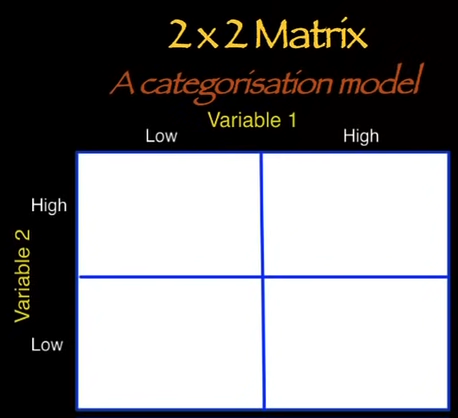
with a sense-making framework on the other hand: the data proceeds the framework, the patterns of the framework emerges from the data
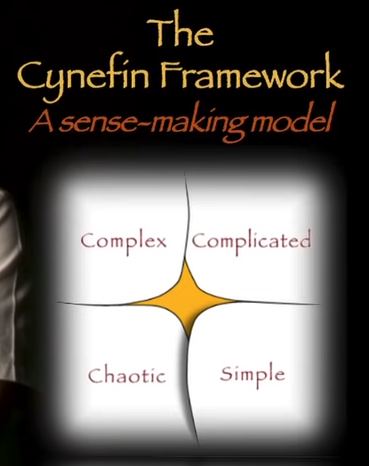
to resume:
- categorisation model: framework precedes data
- sense-making model: data precedes framework
and of course one can become the other over time and will need resetting from time to time
Building the Framework
we take the 3 basic systems:
- Ordered systems
- Complex systems
- Chaotic systems
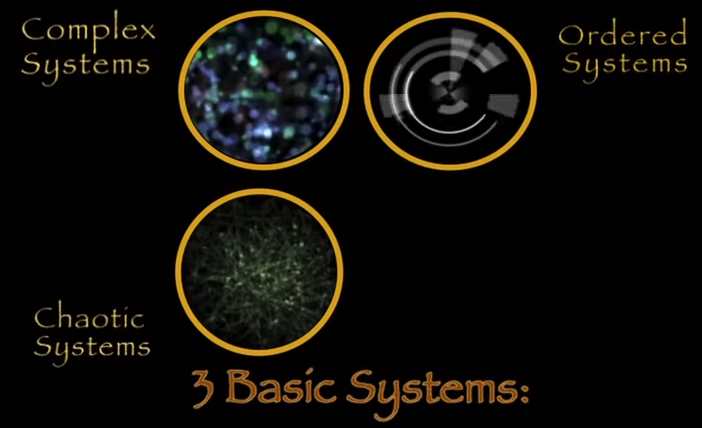
we create a new category: Disordered
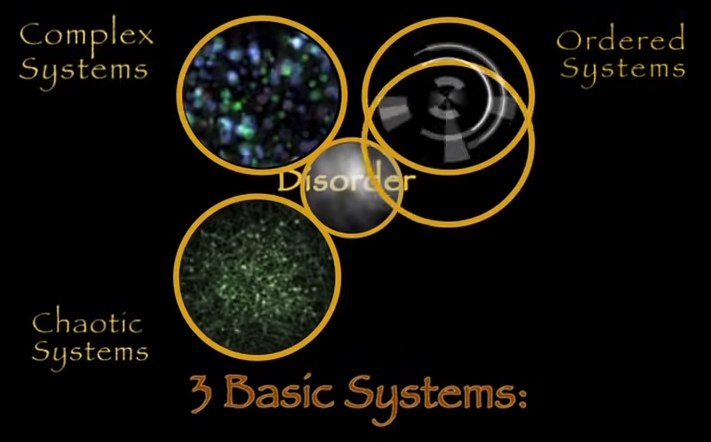
and we divide Ordered into two:
- Simple
- Complicated
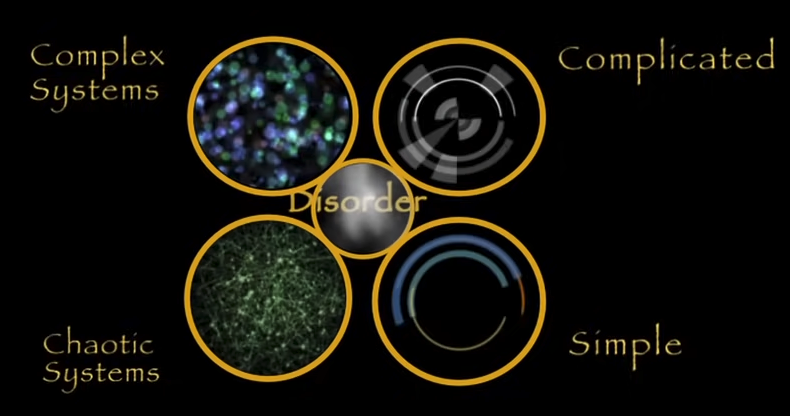
=>
- Simple
- Complicated
- Complex
- Chaotic
- Disordered
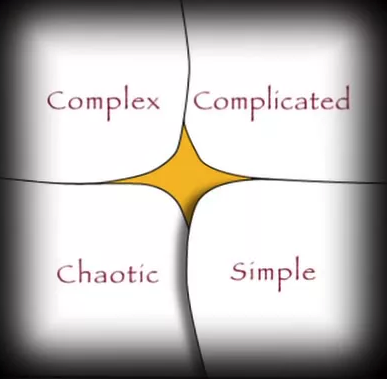
Simple
In a simple domain, this is an ordered system, relationship between cause and effect exists, is predictable, can be determined in advance
that relation is self-evident to any reasonable person
as a result the decision model is: sense - categorise - respond
we see what’s coming in, we can make it fit previously determined categories, we decide what to do
the decision model here is: we apply Best Practice, which is legitimate in this domain, but illegitimate in other domains

Complicated
In a complicated domain, there is a relationship between cause and effect that is the right answer, but is not self evident
so either you have to deploy an analytical matter and: sense - analyse - respond
or call an expert who builds expertise within that domain who can make right decisions
the accordingly applied best practices are Good Practice, the difference between Good and Best Practice is actually quite important.
In a complicated domain there are several different ways of doing things, all of which legitimate, if you have the right expertise. And trying to force people adopt one of them is actually quite dangerous. You will piss off people to be honest where they apply best practice where it should be applied.
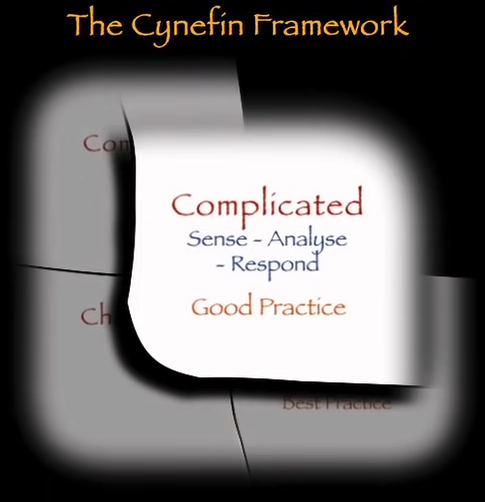
Complex
Complexity on the other hand is a system without causality.
A system of light constraints and agents. Agents modify the system.
Cause and effect are only obvious in hindsight, with unpredictable, emergent outcomes.
the decision model here is: probe-sense-respond
we conduct safe to fail experiments, we don’t do fail-safe design. If an experiment succeeds, we amplify it, if the experiment starts to fail we dampen it. if we actually shouldn’t do an experiment, that is when we identified our amplification or dampening strategy in advance.
what happens here is that we get emergent order. Something that comes out of here is Emergent Practice, is a new way of things, it’s novel. There may be some combination, but it is novel and unique.

Chaotic
In a chaotic environment, if we enter it deliberately it is for innovation, but if we enter it accidentally then we need to stabilise the position quickly.
No cause and effect relationships can be determined.
the decision model is: act - sense - respond
we move very quickly to stabilise the situation.
any practice will be completely Novel Practice in terms of the way the things work
You’ll notice this gives us a very easy way to decide on how to work. But it gives us a divergent, sometimes called a requisite applicability.
It basically says dependent on which phase you are in, you should think differently, you should analyse differently. Rather than the one size fits all, which has been the traditional management theory.
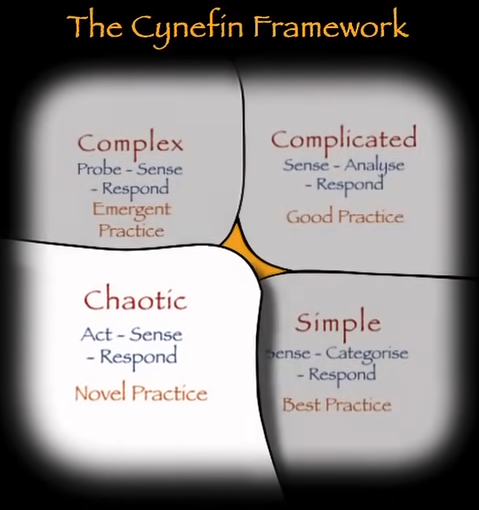
Disorder
the central space, Disorder, and this is key, is the space of not knowing the domain you are in. And that is where we are most of the time.
The trouble there is that we will interpret the situation according to our own preference for action.
- Simple: The danger is if you spent 2 or 3 years of your life in a purely bureaucratic process, then you tend to see all problems as a failure of process.
- Complicated: If you are a deep expert, then your problem is a failure of giving you enough time and resource to do analysis.
- Complex: Natural complexity work is battle-field command as politician. There reaction to a crisis is to get lots of different people together from lots of different backgrounds in a desperate hope that somebody will come with the right solution. That is actually quite a good strategy.
- Chaotic: (nothing said)
And of course the fascist lever crisis, because then they can be given absolute command of everybody who has to do what there told.
What you get in a normal decision environment: people are in a disordered space, assess the situation they are in according to there preference of action.
Main function
One of the main functions of the Cynefin model is to allow people to say: hang on a minute it is complex therefore we probe, or hang on a minute that is complicated which expert should we bring in.
The Simple / Chaotic Boundary
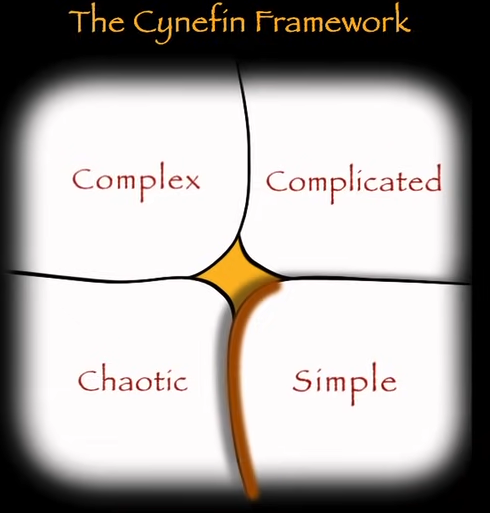
another key aspect of the Cynefin framework: the boundary between Simple and Chaotic is different from the other boundaries (something frequently missed off by people trying to oversimplify the model).
It is actually represented in a Harvard Business review article as a cliff or in other articles as a symbolic type of wave at the bottom.
The principle here is that if you start to belief things are simple, you start to belief they are ordered, you start to belief in your own myths. You start to belief that past success means you are invulnerable to future failure. You effectively moved to the complacence zone which is the boundary between Simple and Chaotic and you fall over the edge in a crisis.
All the other boundaries are there for transition. But this, you fall over the edge and recovery is very, very expensive.
It therefore follows you should manage in a Complicated and Complex space and only move a small amount of material down to the Simple. Because that’s actually highly vulnerable to wrap it or accelerated change.
Conclusion
The Cynefin Framework is a decision framework, it is an analytical framework. It’s been used from decision theories, for knowledge management theory, for IT design, for project management. Because it recognises the causal differences that exist between different types of systems and gives people a very quick and easy way to flip between them so they can use the appropriate method for the appropriate problem.
The Cynefin Framework: a decision-making framework that recognises the causal differences that exist between system types … and proposes new approaches to decision-making in complex social environments.